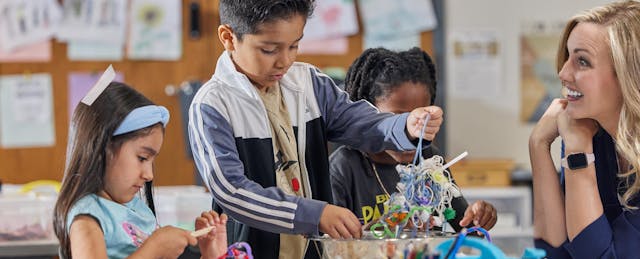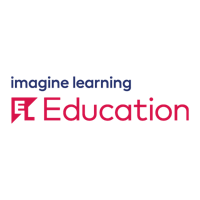“You go into your own world for a moment. Like, if someone's talking to me and I'm reading a book, I wouldn't hear them,” says Aylynn, an eighth grader in Pendergast Elementary District in Phoenix, Arizona. “You can understand someone else's culture, what they celebrate, what they honor and what they believe in, without personally asking. It makes me empathize with other people.”
I spoke to Aylynn as part of a visit to Pendergast with my colleagues from Imagine Learning to hear about educators’ and students’ experiences using the Imagine Learning EL Education curriculum. Her words describe the transformative power of reading — a skill that, unlike spoken language, humans are not naturally hardwired to master. Reading requires building connections in the brain that wouldn’t exist without explicit instruction. As a result, teaching students how to read is a complex and challenging endeavor — that’s why it takes years.

The Science of Reading
Over the past several decades, research in educational psychology, cognitive science and neuroscience has converged to form the science of reading, providing clear, evidence-based guidelines on effective reading instruction. The science of reading distills vast knowledge into practical strategies to help all students become proficient readers, emphasizing a comprehensive approach that includes word recognition, language comprehension and bridging skills.
Word recognition encompasses complex skills such as phonological awareness (recognizing and manipulating sounds in spoken words), phonics (understanding how letters and sounds correspond), and decoding (applying knowledge of letter-sound relationships to pronounce written words). With practice, sight word recognition allows instant recognition of common words.
Language comprehension involves developing background knowledge for context and mastering language structures, such as grammar and syntax, to make sense of sentences and larger texts.
Bridging skills connect these processes. Print awareness helps with the organization of texts, vocabulary knowledge enables the use of a wide range of words and self-regulation helps students manage their reading, maintain focus and apply strategies effectively.
Content-Based Literacy
To address potential breakdowns in reading abilities, schools increasingly turn to digital and blended learning programs that align their curricula with the science of reading. The Imagine Learning EL Education curriculum is deeply rooted in the science of reading, focusing on explicit instruction in the areas outlined above. It offers a content-based approach that combines structured phonics instruction with the use of compelling, real-world texts to engage and excite K-8 learners. In doing so, it aligns with the concept of high-quality instructional materials (HQIMs), a term that an increasing number of school districts use when identifying materials that fulfill criteria such as being aligned to learning standards, offering best-practice pedagogy and delivering a user-friendly experience for both teachers and students.
At Pendergast, the educators I chatted with spoke at length about how helpful they find the program in applying the science of reading principles to practical contexts. “It's nice with Imagine Learning EL Education that the children have explicit phonics instruction,” says Corina, an instructional coach. “But also, there are opportunities in labs for verbal reasoning and vocabulary development and background building, and the children have those hands-on opportunities to apply what they are learning in the module to their lab's time.”
One effective content-based approach to literacy involves students exploring long-form, cross-curricular content. “I love the fact that students are actually reading and spending time in books,” says seventh grade ELA teacher Kathryn. “Not just basals, not just snippets of a story, but actual novels and books.” Every teacher I spoke to at Pendergast echoed that same sentiment — the books bring the curriculum to life for the students.
School principal Abraham agrees: “Having the students have the ability to really dive deep within that text and read the text multiple times is so important for comprehension, especially with our students that are English language learners or that might have a learning disability. [It has] really helped us in closing that achievement gap.”
“When we're looking for those high-quality instructional materials, we're looking for standard alignment,” says Kelsie, assistant director of interdisciplinary literacy, as we talked about the selection process for a new curriculum. “We're also looking for materials that the students can see themselves in. Are they culturally relevant for our kids? We also want them to be able to take that deep knowledge of learning into other aspects of their life and be ready for the future.”

A Passport to Achievement
As I spent time with Kelsie, we talked about the impact for teachers and students, of going on a journey with a curriculum with a holistic pedagogical approach through the grades. “Imagine Learning EL Education is definitely a full gamut of resources that meets all of the different literacy needs,” she says. “Within the program, you will build the foundational skills necessary in K-2. When we go into third through fifth grade, we get to work toward mastery, and then our sixth, seventh and eighth graders take that, and they get to fly. What I love is seeing my students get to be their authentic selves while they're growing in their learning spaces with teachers who are excited to show them how far they can stretch themselves.”
“Reading is like your access to the rest of the world. You have to be able to read," reflects Akin, a school counselor. Imagine Learning EL Education exemplifies how, when the science of reading is brought to life in the classroom, it not only addresses the complexities of learning to read but also prepares students for a future where they can confidently navigate the world through the power of literacy. As Aylynn's experience shows, reading opens doors to understanding, empathy and knowledge, making it a passport to anything students aspire to achieve.



